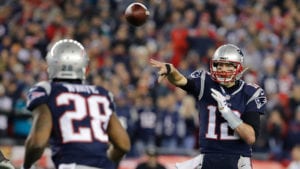Lessons Learned from Championship Weekend (Part Two)

Every year, NFL fans get to watch the league’s top four teams battle it out with a ticket to the Super Bowl on the line. During the greatest Sunday in football, Conference Championship Weekend, fans aren’t the only ones watching. Coaches, general managers, and players from the other 28 teams looked at this weekend to learn what the best teams do, and how they do it. These two games gave every other franchise a model for success, and show the path in which a continually changing league will trend going into the next season.
Previously, I wrote about how the running game and play action matters in the modern NFL. Read Here
Here’s what mattered in the Conference Championship Games:
Defensive Pressure
Defensive pressure disrupts quarterbacks, that is clear. Los Angeles Rams defensive end Dante Fowler Jr.’s hit on New Orleans Saints quarterback Drew Brees in overtime caused a wobbly pass, which was intercepted and allowed the Rams to march down the field for a game winning score. Defensive pressure won the Rams the NFC Championship game, and got them into the Super Bowl. Meanwhile, the Kansas City Chiefs could not generate any pressure on New England Patriots quarterback Tom Brady, and as a result he could wait for his receivers to get open (which often did not take long at all) and pick apart the Kansas City Defense. This part should be obvious, pressure makes quarterbacks worse. Nobody wants to get hit, and it is hard to throw while running away from guys the size of Aaron Donald. But, pressure has to be smart. Especially so given that the Rams and the Patriots have two of the best offensive lines in the league. How can you generate pressure against good teams with good blocking?
First, you manufacture pressure. The Chiefs’ fatal flaw against the Patriots is that they refused to get creative with how to make pressure affect Tom Brady. Instead, through much of the second half and overtime, the Chiefs asked their front four to generate pressure and depended on their defensive backs (DBs) to cover receivers. In theory, adequately covering all of Brady’s targets would give the pass rushers enough time to get to him. This strategy failed miserably. Brady was able to find open targets quickly, and the Chiefs defensive lineman rarely got near him. If the Rams or any team in the NFL hope to succeed against great offenses, they need to disrupt the quarterback. Teams do that through most effectively through blitzing. Blitzes are considered risky, as the defense takes DBs out of coverage and uses them as extra bodies to rush the quarterback. A successful bet results in a DB or linebacker getting pressure on the quarterback to disrupt the play, but a failure means that a receiver could be left open for a big gain. Still, Brady was finding open receivers all day long. The bet of a blitz coming home and disrupting a whole drive far outweighs the downside of a completed pass, yet the Chiefs refused to try. Even if the defense doesn’t get a sack, making the quarterback move his feet and throw an inaccurate pass that falls incomplete is a huge success in this league.
The Rams showed how blitzing can be effective. There were plenty of times where Drew Brees had receivers open, but didn’t have time to look for them. Additionally, the Rams’ use of the blitz allowed them more options when defending against the Saints. Many times, the Rams’ defense will show blitz before the snap, with six or seven defenders crowding the offensive line. But, when the ball is snapped, some defenders will drop back into coverage. As a result, the line will think they have to block multiple defenders but instead are left only blocking three or four pass rushers. When this is successful, multiple offensive lineman will block a single rusher, leaving a different rusher on one-on-one or one-on-none blocking assignment, a task that NFL defensive linemen can win consistently. If they never blitzed, these assignments would not be as effective. The Rams coaching staff properly utilized traditional blitz packages with more innovative rushing/coverage plans to create their own defensive pressure against Drew Brees that the Chiefs failed to do against Tom Brady.
Lastly, pressure does not always mean getting sacks. At the end of the day, the defense simply has to force punts and turnovers. So, modern edge rushers cannot simply rush the passer, betting on getting a hit. Sometimes it is more effective to get a hand up to block a pass, or to stay on the perimeter to cover an easy pass. Part of the reason Patriots’ running back James White is so effective as a pass catcher is that he will sneak out to the sideline late into the play, after an edge rusher has passed him by. Then, while that defender is running towards the Quarterback, the ball is thrown to White, who by this time is uncovered. It is a surefire way the Patriots maintain offensive consistency, picking up solid chunks of yardage even when receivers are covered. For the modern edge rusher, simply using your strength to get to the quarterback is not enough. Defensive linemen must play as smart as they play rough. They must stay aware of the game situation, refuse to be tricked by play action, effectively neutralize short passes to running backs or on screens, and hit the quarterback (but not too hard, you’ll get penalized for that). It’s a tough task, but an important one.
For more NFL coverage, follow @ConnerWickland on Twitter. You’ll be the first to know when Part 3, and everything else, drops.
